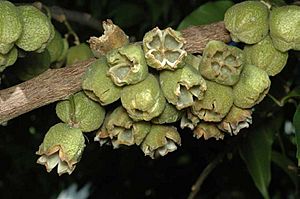Little evodia facts for kids
Quick facts for kids Little evodia |
|
|---|---|
 |
|
| Scientific classification | |
| Genus: |
Melicope
|
| Species: |
rubra
|
| Synonyms | |
|
|
The little evodia (scientific name: Melicope rubra) is a small tree. It belongs to the Rutaceae family, which also includes citrus fruits. This tree is special because it grows only in north-east Queensland, Australia. This means it is endemic to that area.
The little evodia has leaves made of three parts, like a clover. Its flowers are pink and have both male and female parts. These flowers grow in clusters on the branches, usually below the leaves.
Contents
About the Little Evodia Tree
The little evodia usually grows into a tree about 7 meters (23 feet) tall. Its trunk can be around 30 centimeters (12 inches) wide. Sometimes, it can start making flowers and fruits even when it's still a small shrub.
Leaves and Flowers
The leaves of the little evodia grow in pairs, one across from the other. Each leaf has three smaller leaflets. These leaflets are shaped like an egg. They are about 4 to 15 centimeters (1.6 to 5.9 inches) long and 1.5 to 4.5 centimeters (0.6 to 1.8 inches) wide. The main stem of the leaf, called a petiole, is 2 to 7.5 centimeters (0.8 to 3 inches) long. The small stems holding the leaflets can be up to 1 centimeter (0.4 inches) long, or sometimes the leaflets attach directly to the main leaf stem.
The flowers are pink and have both male and female parts. They grow in groups called panicles, which are 2.5 to 6.5 centimeters (1 to 2.6 inches) long. These flower groups grow on the branches below the leaves. Each flower has four sepals, which are small, leaf-like parts at the base of the flower. They are round or egg-shaped and about 1.5 to 2.5 millimeters (0.06 to 0.1 inches) long. The pink petals are 5 to 6 millimeters (0.2 to 0.24 inches) long. There are also four stamens, which are the parts that produce pollen.
Reproduction and Fruit
The little evodia flowers from February to June. After flowering, it produces fruit. The fruit is made of up to four parts called follicles. Each follicle is 2 to 3 centimeters (0.8 to 1.2 inches) long. These parts are joined together for at least half of their length.
Naming the Little Evodia
The little evodia was first officially described in 1900. Two scientists, Carl Adolf Georg Lauterbach and Karl Moritz Schumann, gave it the name Euodia rubra. They wrote about it in a book called Die Flora der Deutschen Schutzgebiete in der Sudsee.
Later, in 2001, another scientist named Thomas Gordon Hartley changed its name. He moved it to a different group of plants, so its new scientific name became Melicope rubra. This new name was published in a science journal called Allertonia.
Where the Little Evodia Lives
The little evodia grows in different types of forests. This includes rainforests. You can find it from sea level up to about 850 meters (2,790 feet) high. It grows in a specific area of north-eastern Queensland, Australia. This area is between a place called Shiptons Flat and the town of Cardwell.
Conservation Status
The Queensland Government has a law called the Nature Conservation Act 1992. Under this law, the little evodia is considered to be of "least concern." This means that the plant is not currently at risk of disappearing.


